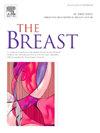Beyond the first cut: Impact of repeat surgery versus boost on breast induration-A post hoc analysis from the DBCG HYPO & PBI trials
IF 7.9
2区 医学
Q1 OBSTETRICS & GYNECOLOGY
引用次数: 0
Abstract
Purpose
Following breast-conserving surgery (BCS), patients with narrow surgical margins frequently undergo repeat surgery (RS) or receive a tumour-bed boost to reduce the risk of local recurrence. Both interventions may increase the risk of late toxicity, including breast induration and adverse cosmetic outcomes. Comparative long-term data on these outcomes remain limited. This post hoc analysis assessed the impact of RS and tumour-bed boost on grade 2–3 breast induration and cosmetic outcomes in patients receiving whole-breast irradiation (WBI) for early-stage breast cancer or ductal carcinoma in situ (DCIS).
Results
The analysis included 1919 patients from two multicentre randomised phase III trials within the Danish Breast Cancer Group (DBCG): DBCG HYPO (WBI 50Gy/25fr versus 40Gy/15fr) and DBCG PBI (40Gy/15fr, WBI versus partial breast irradiation (PBI)). Of these, 303 patients (16 %) underwent RS and 220 patients (11 %) received a boost. Patients were categorised into four groups: ‘RS and boost’, ‘boost only’, ‘RS only’, and ‘No RS, no boost’. At 5 years, the cumulative incidence of grade 2–3 breast induration was highest in the ‘RS and boost’ group (30.7 %), followed by ‘boost only’ (25.7 %), ‘RS only’ (18.1 %), and ‘No RS, no boost’ (13.5 %). Adjusted hazard ratios confirmed this pattern. No significant differences in cosmetic outcomes were observed between the ‘RS only’ and ‘boost only’ groups at 3 or 5 years.
Conclusions
A tumour-bed boost was associated with a higher risk of breast induration compared to RS, with no difference in cosmetic outcome.
第一次手术后:重复手术对乳房硬化的影响- DBCG HYPO和PBI试验的事后分析
目的保乳手术(BCS)后,手术切缘狭窄的患者经常进行重复手术(RS)或肿瘤床强化以降低局部复发的风险。这两种干预措施都可能增加晚期毒性的风险,包括乳房硬化和不良的美容结果。关于这些结果的比较长期数据仍然有限。这项事后分析评估了RS和肿瘤床增强对接受全乳照射(WBI)治疗早期乳腺癌或导管原位癌(DCIS)患者2-3级乳房硬化和美容结果的影响。该分析包括来自丹麦乳腺癌组(DBCG)的两项多中心随机III期试验的1919例患者:DBCG HYPO (WBI 50Gy/25fr vs 40Gy/15fr)和DBCG PBI (40Gy/15fr, WBI vs部分乳房照射(PBI))。其中,303名患者(16%)接受了RS治疗,220名患者(11%)接受了强化治疗。患者被分为四组:“RS和boost”,“仅boost”,“仅RS”和“无RS,无boost”。5年时,“RS + boost”组2-3级乳房硬化累积发生率最高(30.7%),其次是“仅boost”组(25.7%)、“仅RS”组(18.1%)和“不RS + boost”组(13.5%)。调整后的风险比证实了这一模式。“仅RS”组和“仅boost”组在3年或5年的美容结果没有显著差异。结论与RS相比,肿瘤床增强与乳房硬化的风险较高相关,但美容结果无差异。
本文章由计算机程序翻译,如有差异,请以英文原文为准。
求助全文
约1分钟内获得全文
求助全文
来源期刊

Breast
医学-妇产科学
CiteScore
8.70
自引率
2.60%
发文量
165
审稿时长
59 days
期刊介绍:
The Breast is an international, multidisciplinary journal for researchers and clinicians, which focuses on translational and clinical research for the advancement of breast cancer prevention, diagnosis and treatment of all stages.
 求助内容:
求助内容: 应助结果提醒方式:
应助结果提醒方式:


